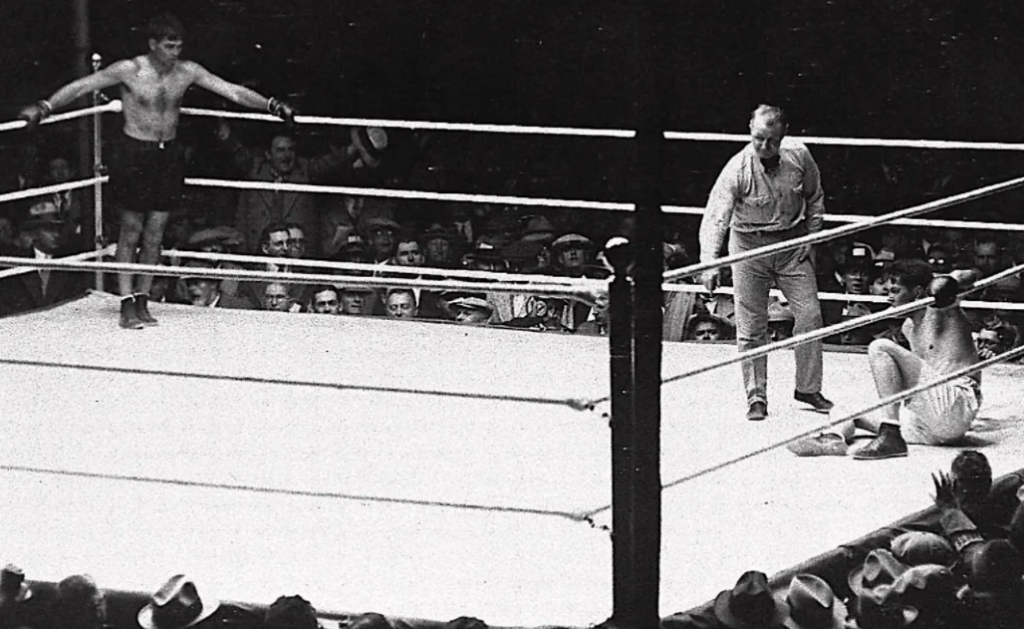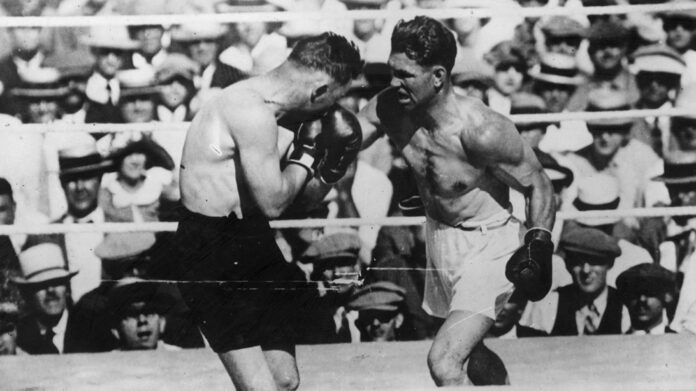Jack Dempsey, the “Manassa Mauler,” was one of the most feared fighters in boxing history. He won his first world championship in 1919 at age 18 and went on to win six heavyweight titles before retiring in 1926 with a record of 84-6-2.
Jack Dempsey’s Championship Fighting is a book written by Jack Dempsey. The book was first published in 1953 and tells the story of his life, including his fight with Gene Tunney for the world heavyweight championship.
You’ll be taken to an online scan of Jack Dempsey’s famous Championship Fighting text by clicking the picture below. Here you may also find other formats.
Please keep in mind that if you want to read the online version, you may need to adjust the magnification by clicking the + or – lens in the bottom right corner. Failure to do so may result in the loss of some pages.
In terms of the content, Dempsey’s book is a must-read for everyone interested in boxing. Learning from great warriors who came before us is always beneficial. It’s less important if you agree with Dempsey on every point. As Bruce Lee would say, take in what you need and reject what you don’t.
In terms of his training philosophy, I agree with many of Dempsey’s views. He was a firm believer in utilizing sports as the main form of conditioning. Sparring, fast shadow boxing, and bag training were all important conditioners for him.
When it comes to sparring, Dempsey says:

“While certain workouts aid with conditioning and others help with progress, there is one activity that helps with both. Sparring is the term for this activity. SPARRING DOESN’T HAVE A SUBSTITUTE. You must spar often and on a regular basis… Sparring not only enhances your ability, but it also prepares your body for combat by pushing your muscles to adapt to the violent, broken motions that set fighting apart from other sports…
Sparring is the most essential conditioning exercise, at least for a beginner.”
Dempsey says this about shadow boxing:
“Shadow-boxing is the next greatest workout for conditioning and sharpening at the same time. Fighting a fictitious opponent is one way to explain it. It’s very beneficial for improving footwork. Although most professional fighters do not wear boxing gloves when shadowing, novices should. Their increased weight will aid in the development of stamina. Carry out the same attacking and defensive motions you would in sparring when shadow-boxing. Your imagined combat should be done at maximum speed to be most useful. There are far too many scrappers that slack off at this job.”
When it comes to bag work, Dempsey says:
“Bag-punching is another conditioning and sharpening activity… Working on the punching bags will tone and develop all of the muscles used in boxing. Your chest, shoulders, and arms will take on the sleek, well-rounded look that separates most fighters’ bodies from those of other guys.”
Dempsey goes on to talk about how important it is to run and jump rope.
When it comes to running, he says:
“Running builds stamina and strengthens the legs. It also helps you lose weight… After your feet have toughened and you’ve grown used to roadwork, vary your runs by sprinting for 100 yards, then jogging, then shadow-boxing for a few seconds, then jogging, then sprinting, and so on.”
He says the following about the jump rope:

“When you skip, you don’t leap with both feet at the same moment, nor do you skip like a schoolgirl with a hippity-hop. You instead bounce off one foot, then the other. At first, it will seem uncomfortable; nevertheless, you will soon be skipping with easy elegance, surprising yourself and your companions. You may learn to ski backwards to make it more interesting. You may learn how to cross the rope forward and backward, as well as how to make the rope travel around you twice while in the air. With the rope, you’ll have a lot of fun. You’ll be able to perform footwork while skipping, and maybe even dance a jig as the rope is spinning around you. Obviously, the skipping is done at a gym or anywhere you’re utilizing as a gym. At each exercise, do at least two rounds of skipping.”
He goes on to talk about how calisthenics and defensive workouts may help you stiffen your core, improve your neck, and strengthen your hands.
In conclusion, Dempsey was a firm believer in training oneself via athletics. Basic exercises like jogging, rope skipping, and calisthenics were then added to the mix. Many contemporary boxing coaches, ironically, use a similar technique. Those who have worked as coaches in the sport understand the importance of real boxing instruction. Work like this is essential not just for skill development, but also for conditioning.
Unfortunately, the importance of athletic training is seldom discussed in the media. Trainers in the sport of boxing seldom write training articles. Strength and conditioning coaches are more likely to write such content. As a result, it’s no surprise that the majority of conditioning-related literature focuses on other aspects of training. If the S&C coach isn’t engaged in boxing instruction, he’ll write about anything else. He would effectively reduce his own importance if he did not emphasize other areas.
Please don’t misunderstand my intentions when I make these remarks. I’m not here to disparage the strength and conditioning industry. However, as a boxing coach, I think that some S&C instructors over-involve themselves in the training process. As a consequence, the fighter is unable to devote as much attention to the sport as he or she would want (ie. sparring, mitt work, bag work, etc.). These are the activities that are most essential for the fighter’s skill and conditioning development.
This isn’t to imply that the supplementary work isn’t valuable or relevant. Supplemental conditioning for fighters, I think, can make a difference. However, such effort will always take a back seat to the real sport. Many previous and current dominating champions were well conditioned fighters who lacked any of the new-school improvements that are often promoted nowadays. Athletes who relied significantly on the sport thrived. They sparred furiously. They slammed their fists into the sacks. They slammed the mitts together. They were meticulous in their execution of their workouts. In terms of equipment or programming, there was nothing spectacular.
In conclusion, although I am always open to new ideas, I am also aware that fighters have been highly trained for many years. Working out with the gloves on is the greatest method for a boxer to get in shape. Then, in tiny dosages, more work may be introduced. These additions may be beneficial, but don’t let them conflict with or take priority over the sport itself.
Jack Dempsey, the how did jack dempsey die was a heavyweight boxer. He died on September 23rd, 1923 after being knocked out in a fight against Georges Carpentier.
Frequently Asked Questions
Did Moses page fight Jack Dempsey?
There is no evidence that Moses Page ever fought Jack Dempsey.
How many fights did Jack Dempsey win?
Jack Dempsey is a highly controversial figure in boxing history. Many argue he never won any of his fights, while others argue that he did win some of them.
Did Dempsey fight Jack Johnson?
Dempsey did fight Jack Johnson, but not in the way you may be thinking.




